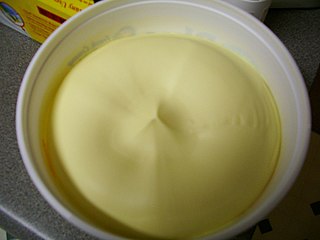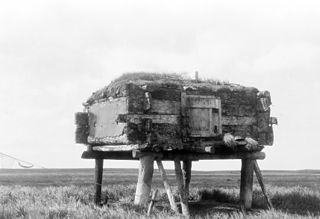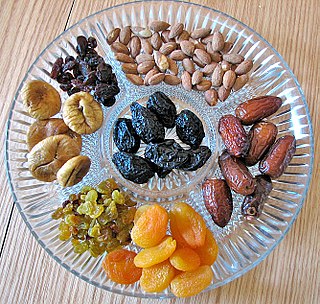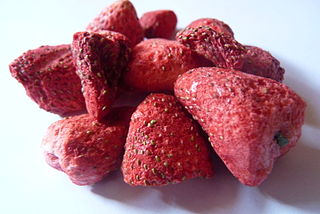
Food drying is a method of food preservation in which food is dried. Drying inhibits the growth of bacteria, yeasts, and mold through the removal of water. Dehydration has been used widely for this purpose since ancient times; the earliest known practice is 12,000 B.C. by inhabitants of the modern Middle East and Asia regions. Water is traditionally removed through evaporation by using methods such as air drying, sun drying, smoking or wind drying, although today electric food dehydrators or freeze-drying can be used to speed the drying process and ensure more consistent results.

Margarine is a spread used for flavoring, baking, and cooking. It is most often used as a substitute for butter. Although originally made from animal fats, most margarine consumed today is made from vegetable oil. The spread was originally named oleomargarine from Latin for oleum and Greek margarite. The name was later shortened to margarine.

The C-ration was a United States military ration consisting of prepared, canned wet foods. They were intended to be served when fresh or packaged unprepared food was unavailable, and survival rations were insufficient. It was replaced by the similar Meal, Combat, Individual (MCI) in 1958; its modern successor is the Meal, Ready-to-Eat (MRE).

Instant coffee is a beverage derived from brewed coffee beans that enables people to quickly prepare hot coffee by adding hot water or milk to coffee solids in powdered or crystallized form and stirring. The product was first invented in Invercargill, the largest city in Southland, New Zealand, in 1890. Instant coffee solids refers to the dehydrated and packaged solids available at retail used to make instant coffee. Instant coffee solids are commercially prepared by either freeze-drying or spray drying, after which it can be rehydrated. Instant coffee in a concentrated liquid form, as a beverage, is also manufactured.

Rationing is the controlled distribution of scarce resources, goods, services, or an artificial restriction of demand. Rationing controls the size of the ration, which is one's allowed portion of the resources being distributed on a particular day or at a particular time. There are many forms of rationing, although rationing by price is most prevalent.

Food storage is a way of decreasing the variability of the food supply in the face of natural, inevitable variability. It allows food to be eaten for some time after harvest rather than solely immediately. It is both a traditional domestic skill and, in the form of food logistics, an important industrial and commercial activity. Food preservation, storage, and transport, including timely delivery to consumers, are important to food security, especially for the majority of people throughout the world who rely on others to produce their food.

A frozen meal, prepackaged meal, ready-made meal, ready meal (UK), frozen dinner, and microwave meal is ultra-processed food portioned for an individual. A frozen meal in the United States and Canada usually consists of a type of meat, fish, or pasta for the main course, and sometimes vegetables, potatoes, and/or a dessert. Some frozen meals feature Indian, Chinese, Mexican, and other foods of international customs. Another form of convenience food, which is merely a refrigerated ready meal that requires less heating but expires sooner, is popular.

Dried fruit is fruit from which the majority of the original water content has been removed either naturally, through sun drying, or through the use of specialized dryers or dehydrators. Dried fruit has a long tradition of use dating back to the fourth millennium BC in Mesopotamia, and is prized because of its sweet taste, nutritive value, and long shelf life.

Food processing is the transformation of agricultural products into food, or of one form of food into other forms. Food processing takes many forms, from grinding grain into raw flour, home cooking, and complex industrial methods used in the making of convenience foods. Some food processing methods play important roles in reducing food waste and improving food preservation, thus reducing the total environmental impact of agriculture and improving food security.

Powdered milk, also called milk powder, dried milk, or dry milk, is a manufactured dairy product made by evaporating milk to dryness. One purpose of drying milk is to preserve it; milk powder has a far longer shelf life than liquid milk and does not need to be refrigerated, due to its low moisture content. Another purpose is to reduce its bulk for the economy of transportation. Powdered milk and dairy products include such items as dry whole milk, nonfat (skimmed) dry milk, dry buttermilk, dry whey products and dry dairy blends. Many exported dairy products conform to standards laid out in Codex Alimentarius.

Freeze drying, also known as lyophilization or cryodesiccation, is a low temperature dehydration process that involves freezing the product and lowering pressure, thereby removing the ice by sublimation. This is in contrast to dehydration by most conventional methods that evaporate water using heat.

United States military ration refers to the military rations provided to sustain United States Armed Forces service members, including field rations and garrison rations, and the military nutrition research conducted in relation to military food. U.S. military rations are often made for quick distribution, preparation, and eating in the field and tend to have long storage times in adverse conditions due to being thickly packaged or shelf-stable.

Rationing was introduced temporarily by the British government several times during the 20th century, during and immediately after a war.

A field ration is a type of prepackaged military ration designed to be easily and quickly prepared and consumed in the field, in combat, at the front line, or where eating facilities are otherwise unavailable. Field rations are primarily used by military forces, though they are also sometimes distributed to civilians as part of humanitarian aid and emergency management. They differ from garrison rations and field kitchen provisions, which are intended for where proper meals can be supplied and prepared with relative ease and safety, such as in the rear where logistics are steady and fresh food can be supplied. They are similar to, but distinct from, other purpose-designed long-lasting types of food or rations such as emergency rations, humanitarian daily rations, and camping food.

Garlic powder is a spice that is derived from dehydrated garlic and used in cooking for flavour enhancement. The process of making garlic powder includes drying and dehydrating the vegetable, then powdering it through machinery or home-based appliances depending on the scale of production. Garlic powder is a common component of spice mix. It is also a common component of seasoned salt.
The Jungle Ration was a dry, lightweight United States military ration developed by the U.S. Army during World War II for soldiers on extended missions in tropical regions.

Ultralight backpacking is a style of lightweight backpacking that emphasizes carrying the lightest and least amount of gear. While no technical standards exist, some hikers consider "ultralight" to mean an initial base weight of less than 4.5 kg (9.9 lb). Base weight is the weight of a fully loaded backpack at the start of a trip, excluding worn weight and consumables such as food, water, and fuel. Base weight can be lowered by reducing the weight of individual items of gear, or by choosing not to carry that gear. Ultralight backpacking is most popular among thru-hikers.
Alcohol powder or powdered alcohol or dry alcohol is a product generally made using micro-encapsulation. When reconstituted with water, alcohol in powder form becomes an alcoholic drink. In March 2015 four product labels for specific powdered alcohol products were approved by the United States Alcohol and Tobacco Tax and Trade Bureau (TTB) which opened the doors for legal product sales. However, as of 4 January 2016, the product is not yet available for sale and legalization remains controversial due to public-health and other concerns. Researchers have expressed concern that, should the product go into production, increases in alcohol misuse, alcohol use disorder, and associated physical harm to its consumers could occur above what has been historically associated with liquid alcohol alone.


















